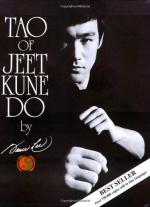
|
| Name: _________________________ | Period: ___________________ |
This test consists of 15 multiple choice questions and 5 short answer questions.
Multiple Choice Questions
1. How does Lee suggest a feint makes the opponent react?
(a) At a fearful level.
(b) At an intellectual level.
(c) At a reflex level.
(d) At a physical level.
2. Who does Lee say that counterattacking is safer for?
(a) Neither fighter has an advantage.
(b) The fighter using it.
(c) The fighter with more training.
(d) The fighter receiving it.
3. What does Lee teach a fighter may minimize by feinting, changing body position or using a variety of attacks and defenses?
(a) Losing balance.
(b) Injury.
(c) Appearing weak.
(d) Danger of a counter.
4. What does Lee compare a man's movement to without obstruction?
(a) A leaf blowing in the wind.
(b) A flash of lightening.
(c) An old growth tree.
(d) A soaring bird.
5. What does Lee believe opens spiritual insight?
(a) Fencing.
(b) Jeet Kune Do.
(c) Meditation.
(d) Nirvana.
6. Lee says that the key element of Jeet Kune Do is its _____ that permits it to have all technique.
(a) Openness to ideas.
(b) Attention to detail.
(c) Lack of technique.
(d) Teachers.
7. What move does Lee teach for forcing the opponent to move to avoid an apparent attack?
(a) The feint.
(b) The escape.
(c) The counter attack.
(d) The parry.
8. According to Lee, how should the movements of an opponent who is very fast and cannot be feinted, be countered?
(a) With the bind.
(b) With the beat.
(c) With a feint.
(d) With the croise.
9. What move does Lee teach that shifts the weight and changes the feet while remaining balanced?
(a) Weaving.
(b) Sidestepping.
(c) Lunging.
(d) Pivoting.
10. What strategy does Lee use for avoiding a blow without moving the body out of range with straight leads and counters?
(a) Punching.
(b) Slipping.
(c) Ducking.
(d) Parrying.
11. What does Lee teach is the purpose of a feint?
(a) To improve muscle function.
(b) To use enough motion to deflect a blow.
(c) To reduce an opponent's coordination.
(d) To increase a fighter's arsenal.
12. What does Lee conclude is based on feints and actions connected to them?
(a) All sports.
(b) Boxing.
(c) Jeet Kune Do.
(d) Martial arts.
13. What does Lee say involves observing the opponent's habits, virtues, and faults?
(a) Selecting tactics.
(b) A character study.
(c) Scientific observation.
(d) Preliminary analysis.
14. What does Lee instruct fighters to use to coordinate closing and opening distances?
(a) Arm span.
(b) Non-thinking.
(c) An estimation.
(d) Hands and feet.
15. What attack occurs in the same line as the original action when the opponent retreats without a parry?
(a) The original.
(b) The progressive indirect.
(c) The delayed.
(d) The renewed.
Short Answer Questions
1. What does Lee teach as a fast forceful backward movement that allows further retreat or stepping forward to attack?
2. What move does Lee say make the fighter harder to hit and leaves the hands open for attack?
3. How many principles does Lee outline for distance in attacks?
4. What does Lee say is made when a fighter decides or opponent movement occurs or fails?
5. How does Lee distinguish the parry from a block?
|
This section contains 531 words (approx. 2 pages at 300 words per page) |

|




